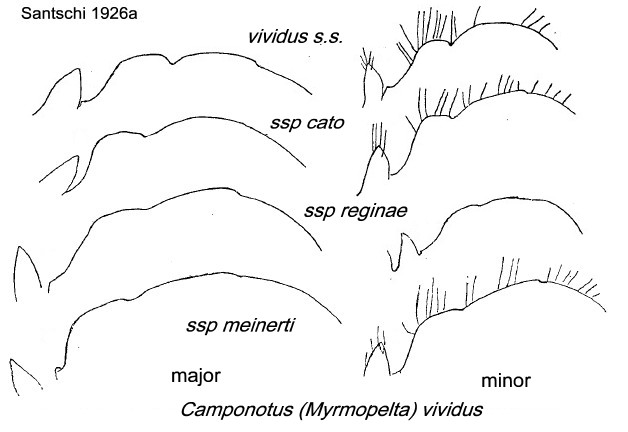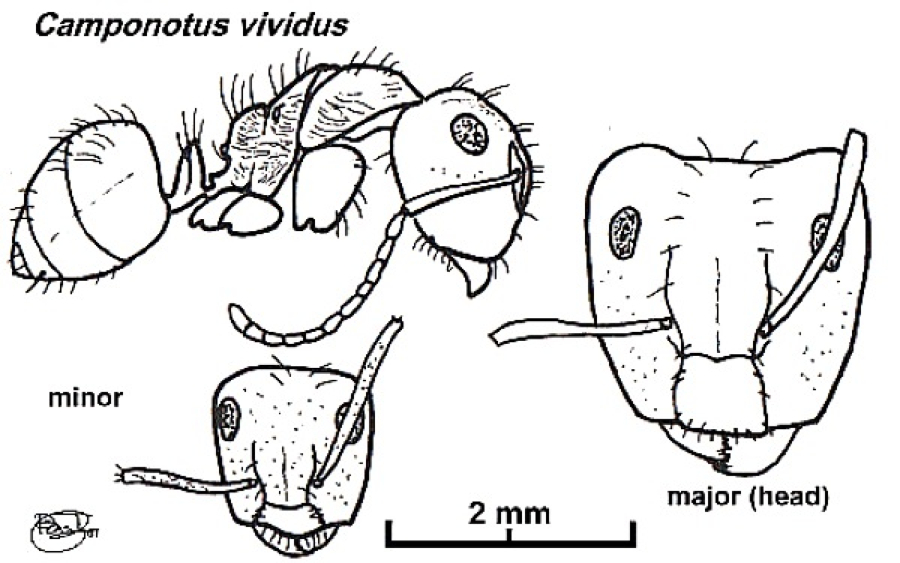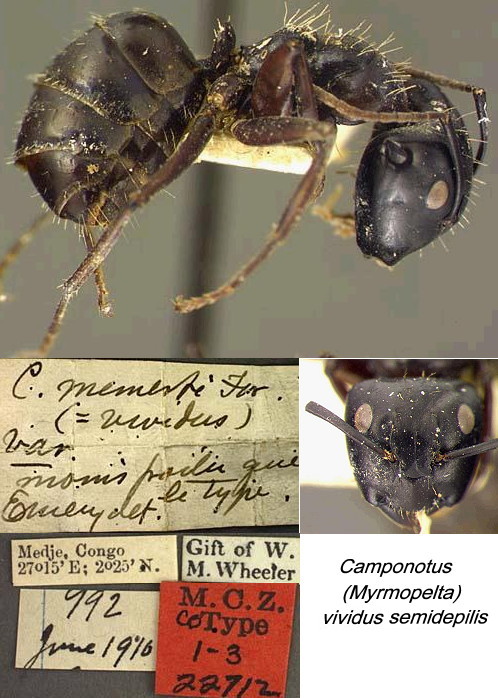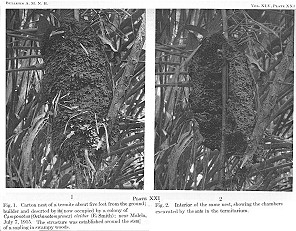Camponotus (Myrmopelta) vividus (F. Smith)
  Type location Sierra Leone
(Formica vivida, F. Smith, 1858b: 31, minor worker) collected by
D.F. Morgan - see below Type location Sierra Leone
(Formica vivida, F. Smith, 1858b: 31, minor worker) collected by
D.F. Morgan - see below
subspecies
cato (Camponotus
(Orthonotomyrmex) Meinerti For. r. cato n. stirps, Forel, 1913b: 346,
soldier & worker) Zaïre - see linked page
semidepilis (Wheeler, 1922: 248, major & minor
workers) Zaïre - see below
meinerti (Camponotus
Meinerti n. sp., Forel, 1886f: 189, major & minor workers
& queen) Angola - no images on Antweb (September 2014)
reginae (Camponotus
Reginae n. sp., Forel, 1901d: 307, given as Camponotus (Orthonotomyrmex) Meinerti
For. r. Reginae For, by Forel
1913b: 346, queen described; major & minor workers; Arnold, 1924:
719,
queen) Angola - see queen http://www.antweb.org/specimenImages.do?code=casent0903486
junior synonyms
laboriosa (Formica
laboriosa, F Smith, 1858b: 32, queen, "probably the female of F. vivida") Sierra Leone -
no images on Antweb (September 2014)
and laevithorax (Camponotus
vividus var. laevithorax
n. var., Menozzi, 1924b: 227, illustrated, major worker; synonymy with cato
Menozzi, 1933a: 113) Uganda - no images on Antweb (September
2014)
major & minor workers & queen
described (see Bolton, 1995)  . .
|
 F Smith's
original description (1858b) is at F Smith's
original description (1858b) is at  ; Santschi (1926a) summarised the species
and subspecies description, these are at ; Santschi (1926a) summarised the species
and subspecies description, these are at  ; he also provided the outline drawings of
the thorax and petiole scale of species and subspecies (right). ; he also provided the outline drawings of
the thorax and petiole scale of species and subspecies (right).
Forel's (1886f) description of meinerti is at  and and  . Forel's (1901d)
description of reginae is at . Forel's (1901d)
description of reginae is at  Forel's (1913b)
description of cato is at Forel's (1913b)
description of cato is at  Forel's (1913b) description of reginae
is at Forel's (1913b) description of reginae
is at  Menozzi's description
(1924b) of laevithorax is at Menozzi's description
(1924b) of laevithorax is at  ; Arnold (1924) gave a
translation of reginae (of which he regarded meinerti
as a synonym); this is at ; Arnold (1924) gave a
translation of reginae (of which he regarded meinerti
as a synonym); this is at  . .
Among the numerous locations from throughout forest
areas of sub-Saharan Africa, Wheeler (1922) listed Senegal (at
Dakar, F. Silvestri), Guinea (Los Islands by H, Brauns, Samlia
Falls by Mocquerys), Liberia (by Keiselbach, and at Monrovia
by Duke), Ghana (Accra and Addah), Togo (Bismarckburg
by Conradt), Nigeria (Olokemeji, F. Silvestri), Cameroun (Mundame
by Conradt; Bibundi by Tessman; also ssp reginae by Conradt,
and at Victoria by Fickendey).
|
 Nigeria specimens (Taylor, 1978: 11) Nigeria specimens (Taylor, 1978: 11)
MAJOR WORKER - TL 7.73 mm, HL 2.49, HW 2.49, SL 1.77, PW 1.56
MINOR WORKER - TL 5.45 mm, HL 1.56, HW 1.31, SL 1.56, PW 1.06
Colour black, shiny. Sculpturation of fine striations, particularly
evident on the alitrunk. Erect coarse but almost colourless hairs
abundant, and very sparse pilosity. Declivity of propodeum an obtuse
near right-angle. Metanotal groove clearly incised and promesonotal
suture wide. Petiole a sharp scale with a line of erect hairs on the
dorsal edge.
It nests in dead wood on certain species of forest trees and is often
closely associated, as a sub-dominant, with Crematogaster africana.
Found foraging on up to 1.2% of cocoa trees; also on native trees and
plantains; and at 24/76 farms (Taylor & Adedoyin, 1978).
Note: Forel (1886f) gave the meinerti major as
TL 8.5-9.6 mm; the petiole scale weakly convex in front, the dorsum
feebly scalloped. The queen of regiane Forel (1913b: 346) gave
as TL 13.5 mm; apparently smaller than the type queen.
|
 The
photomontage is of the holotype major worker collated
from http://www.antweb.org/specimen.do?name=casent0903485 The
photomontage is of the holotype major worker collated
from http://www.antweb.org/specimen.do?name=casent0903485
|
 Wheeler
(1922) illustrated (right) both the nominal form, the ssp cato
(Forel) and described a new variety semidepilis (bottom right),
which differed from the typical form in having paler and much less
numerous erect hairs of the dorsum of the head and body, plus lesser
pubescence on the gaster. In many findings from Zaïre, nests had been
found "rather rotten portions of a tree" and in a large former termite
carton nest (illustrated right and "click"), when crushed the ants
"gave off a stench like bugs" (shield bugs, presumably). Wheeler
(1922) illustrated (right) both the nominal form, the ssp cato
(Forel) and described a new variety semidepilis (bottom right),
which differed from the typical form in having paler and much less
numerous erect hairs of the dorsum of the head and body, plus lesser
pubescence on the gaster. In many findings from Zaïre, nests had been
found "rather rotten portions of a tree" and in a large former termite
carton nest (illustrated right and "click"), when crushed the ants
"gave off a stench like bugs" (shield bugs, presumably).
|
 The phoytomontage of a cotype of Camponotus vividus
semidepilis from Zaïre, is collated from original
photographs from the MCZ, Harvard University, website at - MCZ link. The phoytomontage of a cotype of Camponotus vividus
semidepilis from Zaïre, is collated from original
photographs from the MCZ, Harvard University, website at - MCZ link.
Santschi (1935) reported cato and meinerti
from Zaïre. Latter also by Forel (1911f), by Dr. Dubois from Kinshasa
[Leopoldville], plus reginae from Kondué by Luja. Forel (1911e)
had reginae from Liberia, no collector named.
Reported by Bernard (1952) as very common, from Angola
to Niger. In Guinea not so common; F 72, Yanlé; savanna at
Kéoulenta (abundant); Camp IV at 1000 m. Some queens probably of this
species came from Yalanzou and Mount Tô at 1600 m.
Found in Ghana cocoa by Majer, who found it in
70.1% of his 144 pkd samples at Kade, with 60-70 workers per sample
(1975, 1976a, b, c). Room (1971) found it in 28 cocoa canopy samples.
He also reported its occurrence on cocoa mistletoe (Room, 1972a, 1975),
where it was 11th most abundant insect species, 768 individuals (but in
less than 30/630 cocoa/mistletoe junction samples) and 16th most
frequent on mistletoe plants. Later found by Belshaw & Bolton
(1994b), who collected only two workers at Bunso, as 'tourists' in leaf
litter under cocoa. Room (1971) also found it to be positively
associated with Crematogaster africana.
|
 Listed as a forest species, able to live in degraded
zones, in Ivory Coast by Lévieux & Louis (1975). In a
detailed study they described it as one of the most common arboreal
species in the region. The research was carried out at an unnamed
location in a degraded forest near the coast at Abidjan. The biology of
a nest from apparently the same area had earlier been studied by Soulié
(1967). It often nests at up to 50m above ground, with some 6,000
individuals in a colony of some three years of age. For such a
population to inhabit a single nest would require a cavity of
considerable size within a tree and, hence, the more common situation
is that of polycaly, with some five or six nests per colony. These
small nests are constructed within dead branches, often by reusing the
galleries excavated by other insects, with instances of utilisation of
termite nests (Soulié reported actual elimination of a termite colony).
There may be 1-3 nests on any one tree but no preference for any one
tree species was reported. A typical colony appeared to occupy an area
of some 25 to 35 metres horizontally and up to 60 metres vertically.
The large area was thought to account for the relatively low density of
the species as a whole. Mapping of an area of mixed cocoa, cashew and
forest trees showed its colonies on separate trees from Oecophylla
longinoda and some apparent displacement of the latter by the
vividus colony. Most of its activity was at the beginning and end of
the daylight hours, but heavy rain causing leaf wetting inhibited
activity. Listed as a forest species, able to live in degraded
zones, in Ivory Coast by Lévieux & Louis (1975). In a
detailed study they described it as one of the most common arboreal
species in the region. The research was carried out at an unnamed
location in a degraded forest near the coast at Abidjan. The biology of
a nest from apparently the same area had earlier been studied by Soulié
(1967). It often nests at up to 50m above ground, with some 6,000
individuals in a colony of some three years of age. For such a
population to inhabit a single nest would require a cavity of
considerable size within a tree and, hence, the more common situation
is that of polycaly, with some five or six nests per colony. These
small nests are constructed within dead branches, often by reusing the
galleries excavated by other insects, with instances of utilisation of
termite nests (Soulié reported actual elimination of a termite colony).
There may be 1-3 nests on any one tree but no preference for any one
tree species was reported. A typical colony appeared to occupy an area
of some 25 to 35 metres horizontally and up to 60 metres vertically.
The large area was thought to account for the relatively low density of
the species as a whole. Mapping of an area of mixed cocoa, cashew and
forest trees showed its colonies on separate trees from Oecophylla
longinoda and some apparent displacement of the latter by the
vividus colony. Most of its activity was at the beginning and end of
the daylight hours, but heavy rain causing leaf wetting inhibited
activity.
Writing on the source of food , they described how the bulk (79%) of
its sugar needs are obtained from dried tree gums, especially from
Sterculia traegacantha (Gum Tragacanth, 34% of food) and Anacardium
occidentalis (Cashew, 28% of food), apparently highly unusual if
not unique among ants. Of the remaining diet, 17% was of undetermined
vegetable origin and 21% of animal origin, almost all insects and of no
particular kind. Some sugars came also from Homoptera which were tended
and over which tents of vegetable material, such as bark fragments from
Terminalia callapa, glued to give a rigid domed
structure, with access only through a hole just sufficient to permit
the ant to enter.
|
Photographs of the type form and cato can be
seen on the linked pages at type
form (bright shiny black) and cato
form (noticeably duller appearance) plus sexuals.
|
Oxford University Museum
specimens
|
|